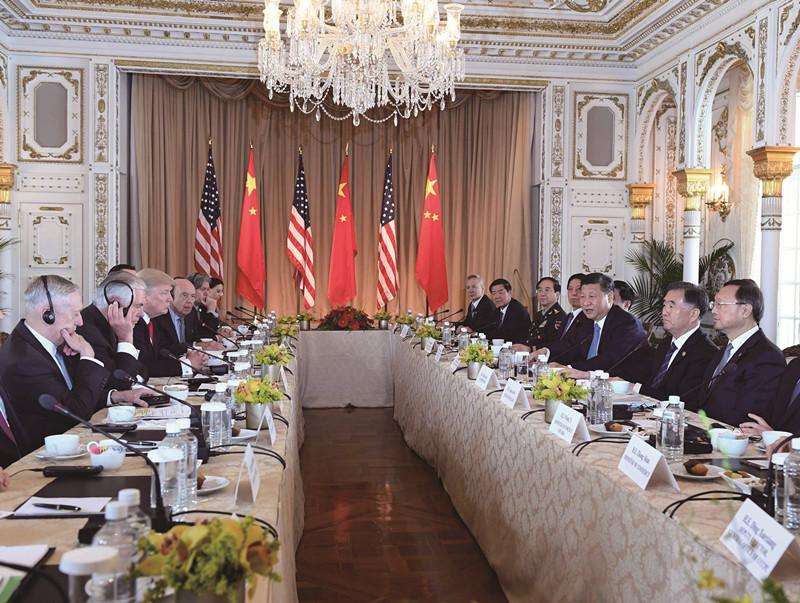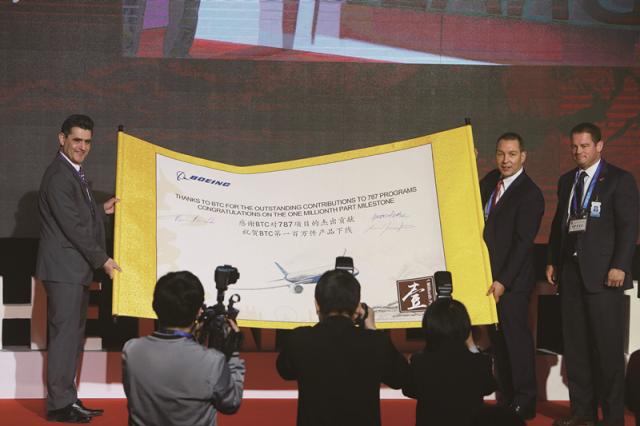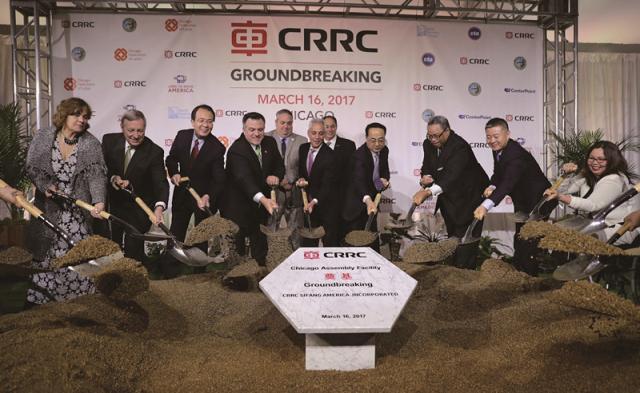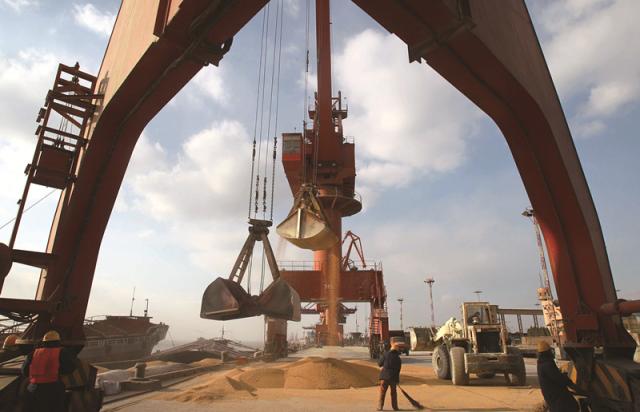Farmers in the US plan to expand their soybean planting in 2017, and China will increase its soybean imports by 1 million tons in the marketing year starting from September 1, 2016, according to forecasts by the US Department of Agriculture published in March and April. Its statistics showed that China was the top export market for the US agricultural products in 2016, with soybeans making up 66 percent.
Meanwhile, Oy Roberts Ab, a Finnish family enterprise that makes jams and ingredients for baked goods, has recently invested almost US$3 million to expand its production lines in Finland to meet the rising demand from Chinese consumers. It expects more cooperation with its Chinese partner on marketing and technology. Sophie Zhang, chief representative of the Shenzhen-based Nordic Trade House Finland, a Finnish trade promotion agency in China, told NewsChina that their member enterprises like Roberts are eager to tap more business opportunities in China. Her office represents more than 6,000 SMEs from the West Coast of Finland, along with Finnish government trade and investment promotion agencies, trade associations and universities.
The significance of these two examples lies in something more than food. The political dynamics behind them are different, yet connected in some way. More troubled trade relations between China and the US have been expected for some time. It is believed that China can use US agricultural products, either soybean or beef, as a deterrent and buffer to prevent the escalation of tension in trade. It is also advised that China seek new trade partners not only to resist US pressure, but also to increase its say in the world economic governance. There are signs that China is trying to do so.
A China-US trade war seems, at least, no longer imminent after the first meeting between Chinese President Xi Jinping and the US President Donald Trump at the Mar-a-Lago estate in Florida on April 6 and 7 local time. A 100-day trade negotiation plan, agreed during the meeting, was described by the US Secretary of Commerce Wilbur Ross as “a very, very important symbolization of the growing rapport between the two countries” in Florida on April 7. President Trump himself told the Wall Street Journal on April 12 that China was “no longer” manipulating its currency to boost its exports. As a result of Xi Jinping’s first visit to Northern Europe as president, from April 4 to 6, China and Finland have declared that they will expand cooperation on an array of areas, including food, agriculture technology, innovation and clean technology.
Trade has been listed as one of the most likely triggers of China-US frictions in numerous Chinese and US analyses since Donald Trump won the presidential election. The recent softened rhetoric on the trade issue, as one of the policy shifts indicated in the Wall Street Journal interview, has surprised international media. Business integration between China and the US may run much wider and deeper than Trump expected, and could be even greater than at present if more avenues of potential were explored. For China, it has the leverage to deal with a shock from the US, and options to find more partners.
Unpredictability is one of the main reasons why Donald Trump had looked so unlikely and unwelcome to win the election, in the eye of Western elite groups and most international analysts. It remains the label attached to his presidency so far. However, despite all the uncertainties he may bring to the bilateral ties and international politics, Chinese and US analysts have not missed one particular certainty. They had always been quite sure, before and after his election, that Donald Trump would wage an attack on imports from China in some way, including, in the worst scenario, a sweeping trade war.
Indeed, Chinese and US analysts have almost reached a consensus on both the most vulnerable Chinese products likely to be the first targeted by the US, and the most effective weapons in China’s arsenal to fight back if necessary. Chinese products from sectors mired by overcapacity are thought to be the most vulnerable. It has already proved true. So far this year the US has already imposed punitive tariffs and trade investigations on about 10 steel, aluminum, tire and chemical products from China. More importantly, the Trump administration has increasingly focused on China’s subsidies, particularly at the local level in China, which they believe is the root of China’s price advantage. Countervailing duties were involved in all these cases. On April 6, the US filed a complaint with the World Trade Organization against unreported subsidies by China’s local governments to their steel, aluminum and fishery companies. On a single day, March 31, Trump issued two executive orders on trade. One requires the US trade offices submit an “omnibus report” within 90 days on identifying trading partners whose policies and practices have contributed to the US trade deficit in 2016. The other is to strengthen US trade law enforcement on foreign sellers.
China’s Ministry of Commerce has protested all these measures. Chinese and US analysts believe if China chooses to counteract any time, it has no lack of ammunition, not just oral protestations.
While China’s huge trade surplus in goods with the US has been the source of US frustration for years, the US has sold many more agricultural products to Chinese consumers than it has bought from Chinese farmers. In addition, China is the largest overseas customer of the US aircraft giant Boeing. According to research released by The China Finance 40 Forum (CF40) on its website on April 3, China can choose to use carrot and stick, importing more US agricultural and energy products to win the support of the states that supply those, and opening itself up to more on service sector as carrot, or restricting imports of US soybean, airplanes and autos as a hefty stick.
These tit-for-tat tools for both sides are evidence of how intensively and extensively the world’s two largest national economies have been trading with each other.
Besides trade, China-US business ties have been increasingly shaped by their investment in each other’s markets. “We have demonstrated that the commercial stakes on both sides are two to four times higher than commonly used statistics suggest,” concluded a report called Two-Way Street by the US National Committee on the US-China Relations and the New York-based consultancy Rhodium Group in November 2016. The research is based on foreign direct investment (FDI) transactions between the two countries from 1990 to 2015 and highlights the turning point in 2015 when the FDI flow from China to the US outstripped that going in the opposite direction. Stephen Orlins, president of the committee, noted at the presentation of the report at the Center for China and Globalization (CCG), a think tank in Beijing, that Trump would be tough on trade, but would welcome any green-field investment which would bring jobs.
Recently, the potential for Chinese companies in the US’s anticipated infrastructure spree has attracted a lot of attention after Trump’s election, particularly after the first Xi-Trump meeting.
Chinese Foreign Minister Wang Yi said that the two leaders “agreed to explore practical cooperation in many fields including energy and infrastructure.” According to a report by the 21st Century Business Herald, Trump met a group of Chinese and US infrastructure business leaders on April 12 local time, when New York and New Jersey Port Authority held a seminar with Chinese and US companies on how the public-private-partnership model can be used to build infrastructure projects there. Chinese participants not only included China Construction America, which already has a strong presence in the US market both as a constructor and investor, but also the financial giant the Industrial and Commercial Bank of China.
In China-US relations, energy cooperation can serve as a new “stabilizer” when trade looks much less effective as serving as the conventional “cornerstone,” wrote Li Zixin of the China Institute of International Studies in his article for China Petroleum Daily on April 18. On his way back home on April 7, Xi met with Governor Bill Walker of Alaska, a resource-rich state. With the energy market today being a buyers’ market, Li does not think it a good idea for the Trump administration to aim to become an energy exporter while waging a trade war against China.
Despite all this, there is little doubt that China has to prepare for a more difficult business relationship during the Trump administration. Zhang Ming, a researcher with the Chinese Academy of Social Sciences and Pangoal, a Beijing think tank, warned in his recent paper that a moderate or partial trade war is still very likely once US economic growth declines again and the country blames others such as China for that. The US stock market may go down after rising rapidly for some time. Trump’s fiscal stimulus plan may not be as strong as expected and the Federal Reserve is showing a hawkish attitude towards monetary policy. All this, he said, would put downward pressure on the US economy.
Chinese enterprises needed to pay more attention to “local politics” in the US, remarked Tang Beijie, Deputy Secretary-General of CCG at the press conference for their report on China-US cooperation on infrastructure on April 5. She explained that local contractors, financial institutions and suppliers in the US would turn to their political connections to put pressure on outside competitors. In addition, at a local level, Americans show little enthusiasm towards some new infrastructure projects as they will mean higher tax bills. The CCG forecast seven opportunities for partnership between Chinese and US participants in US infrastructure projects, including manufacturing, venture capital in the high-tech sector and public-private partnerships.
The headwind against investment heading to the US could also grow stronger. There is not much optimism in China or the US of a conclusion to the bilateral investment agreement in the short run. In addition, Rhodium said in a report on December 30, 2016, there was not only a “surge in letters opposing individual Chinese acquisitions in 2016,” but also “serious efforts underway on Capitol Hill to prepare legislation that would expand the mandates of CFIUS [the inter-agency Committee on Foreign Investment in the US] to review Chinese and other foreign transactions.”
While bilateral trade ties seem to face uncertainties, China is in search of other potential partners. And there happen to be opportunities, and partly thanks to US policy. Trump is putting into action his campaign commitment to go against the current trend of globalization. He withdrew from the Trans-Pacific Partnership (TPP). In March, the US Trade Representative Office released the 2017 Trade Policy Agenda and 2016 Annual Report of the President of the United States. It expresses explicit disappointment towards the world’s current multilateral trading system and makes it clear that abandoning TPP paves the way to a bilateral rather than a regional, multilateral approach. During his campaign, Trump described the World Trade Organization and the North American Free Trade Agreement as a “disaster.” Trump’s winning of the election itself has been regarded as one of the two greatest symbols of a retreat, or even a reversal, of economic globalization. The other is the British referendum decision to leave the European Union.
In contrast, in his speeches at the World Economic Forum in Davos and the United Nations Office at Geneva, Switzerland, in January, Xi Jinping repeatedly defended economic globalization and opposed protectionism. International media interpreted his remarks as a sign of China’s willingness to take over from the US the lead role in economic globalization.
China’s role in economic globalization has become an increasingly controversial topic among Chinese experts. In his article on the online Chinese language version of the Financial Times on March 30, Chen Jianqi of the Party School of the CPC Central Committee argues that it is in China’s own interest to defend the rules of economic globalization and that China is showing the ability to do so. He said that China and the world economy could not afford the possible turbulence from a decision by the US to overturn the existing rules which have underpinned globalization for decades. China is also in the strongest economic position after the US and Europe to push globalization forward. All this, combined with Xi’s message in Switzerland, demonstrates China’s emerging leadership in globalization, Chen concluded.
As Chen recognizes in the article, doubts over China’s leadership abilities are mainstream. At a seminar on globalization sponsored by the CCG on April 9, many experts agreed that the US is trying to resist the part of globalization it feels does not benefit the US, not globalization in its entirety. In terms of capital flow, seminar participants believed more in capital’s pursuit of returns than in Trump’s policy. While they have seen the opportunity for China to have a bigger voice in rule-making in globalization, most of them do not think China is fully ready to be the leader, given China’s mid-to-lower end position in the global supply chain and lack of talents with international vision and experience. As Cui Hongjian of the China Institute of International Studies said at the forum, optimists believe China can succeed where the US fails, while cautious attitudes have seen China’s weakness compared with that of the US. Both actually are using the US as the reference, Cui noted.
An interesting idea is in what situation and in what way China could play a leading role. Professor Jin Canrong of Renmin University of China told NewsChina that China would have the responsibility of assuming the leadership in the extreme case of the US refusing WTO rules.
However, he suggests that even in that situation China still needs to do this in partnership with the EU and its major member states, particularly Germany, which are experienced and adept at economic global governance. The CF40 report also proposed that China should consolidate its cooperation with other major trading partners including Europe to defend the world trade order and the WTO, if the US rejects the two.
There are signs that China is moving closer to Europe. While strengthening relations with major European economies, particularly Germany and Britain, China has stepped up efforts to build stronger ties with the Central and Eastern European countries that form part of China’s Belt and Road initiative. Besides, China is trying to attach more importance to Nordic countries. Before meeting Trump, Xi visited Finland. The two sides not only signed trade-related deals, but also confirmed shared support for “multilateralism, economic globalization and free trade.” They declared in their joint statement that their future-oriented, new-type cooperative partnership would add momentum to China-EU relations.
There is already fast-growing interest among the businesses of the two countries. Besides the heavy presence of Chinese giants Huawei and Tencent in Finland, Finnish SMEs have received a lot of interest from Chinese investors who consider acquiring small but highly tech-savvy companies that can bring profits and technologies to Chinese companies, according to Sophie Zhang at Nordic Trade House Finland. Its member companies are in industries including electronics, shipbuilding, mechanical equipment, food and clean technology.
More importantly, Zhang noted, compared with the US and Western Europe, Finnish people generally have more understanding of China’s political system, and are more positive toward the prospect of China playing a leading role in economic globalization. There is perceived confidence and expectation that China can take the role further with its own continued opening up and moving to a more market-oriented economy, she said.
Whether it acts as a leader or not, China has already been in the position of playing a bigger role in defending economic globalization. It needs new opportunities, new partners and new actions to continue in this direction.

 Old Version
Old Version



